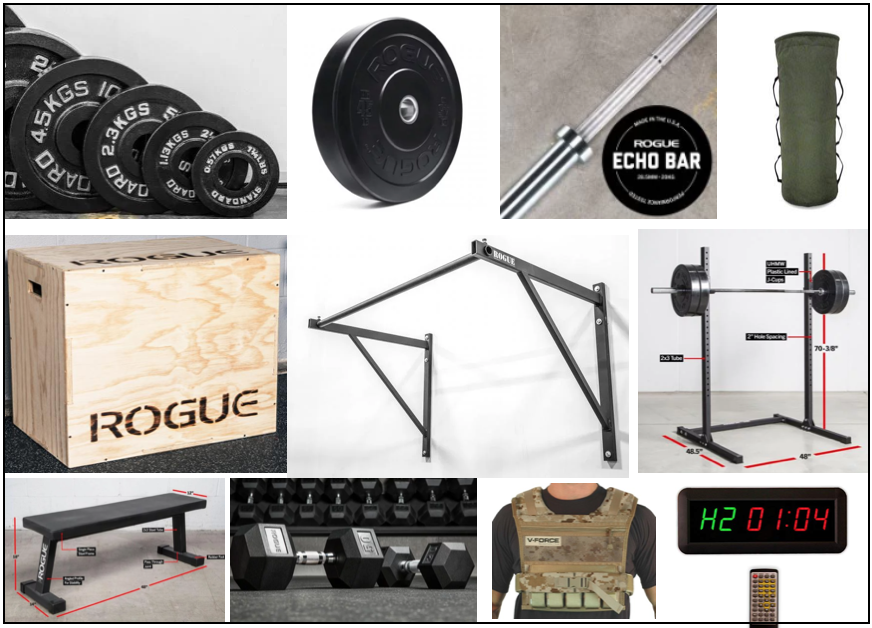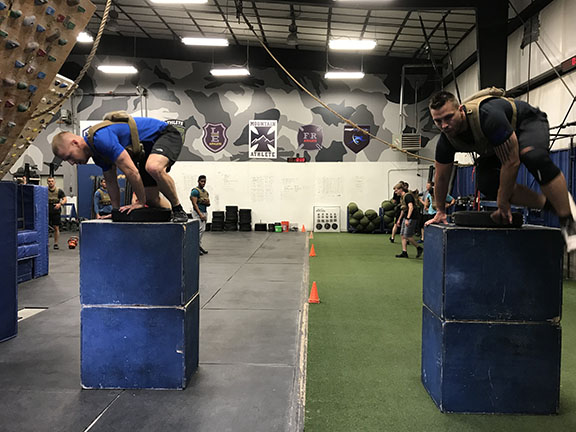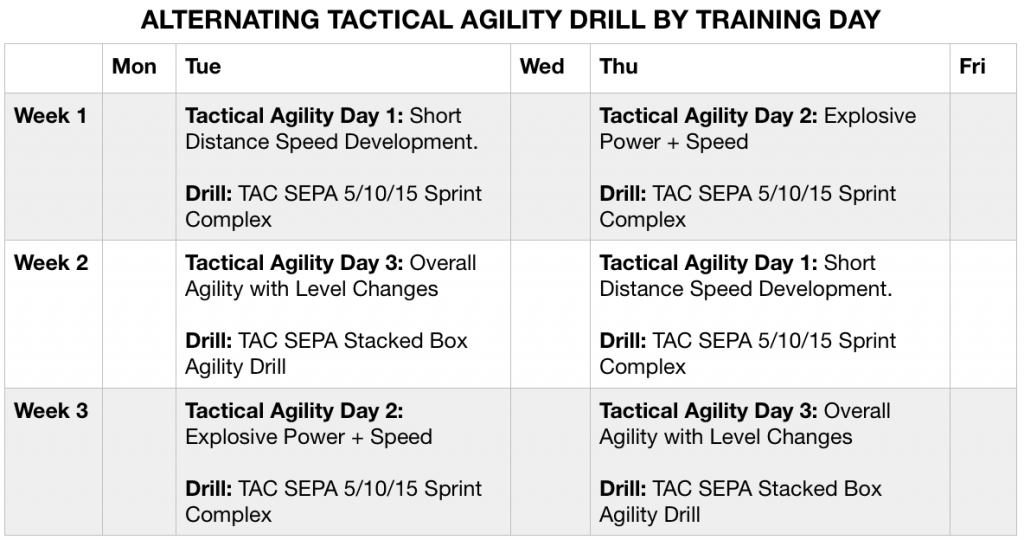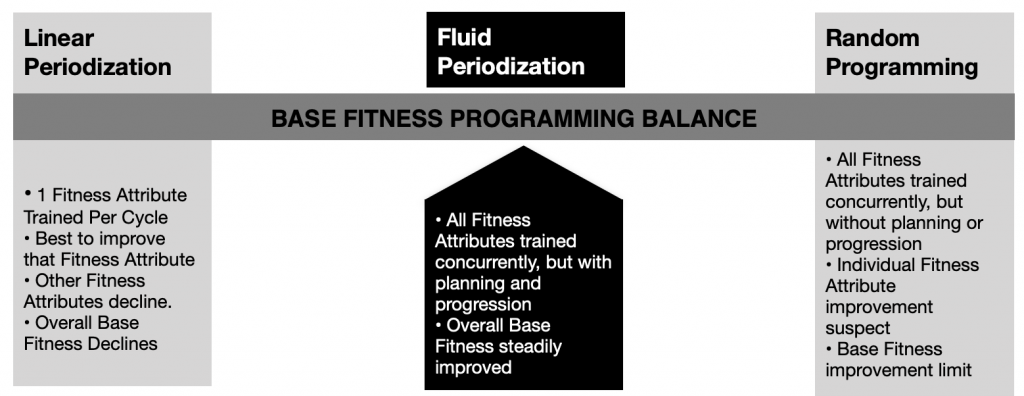QUESTION
I am a Federal Probation Officer in Texas, and I noticed that you have worked with other federal LE agencies. I was wondering if you have any plan recommendations. I am particularly interested in strength and endurance training. I am a member if our agencies health and wellness team and would like to pass along some recommendations at our next meeting.
ANSWER
For Patrol/Detective Officers I recommend the plans/order in the
Spirits Packet. These plans concurrently train strength, work capacity, upper body hypertrophy, tactical agility and chassis integrity (core).
For full time SWAT/SRT, I recommend the plans/order in the
Gun Maker Packet. These plans concurrently train strength, work capacity, endurance including rucking, and chassis integrity.
If your specific job description includes making arrests, I’d recommend the Spirits Packet. If not, and you’re mostly interested in a solid plan which trains both strength and endurance specifically, I’d recommend
Patsy.
– Rob
QUESTION
I am training for SWAT school coming up in November. Part of the process is a high volume stress or hell day. I have completed the day before but need to improve on my performance.
I have been browsing through the programs on your site including the LE SWAT type stuff, Rangers, and PJs. All of them have movements similar to our process but I am unsure about how best to train for the volume required during the day. It doesn’t seem like I’m doing enough. I’m familiar with the idea that short burst of high intensity work can improve your ability to do endurance work.
How can I best prepare myself for a day of high volume training with push ups (400+?,) running, air squats, flutter kicks, pool work, and a few hours of obstacle course work…..without overtraining? (I have access to an obstacle course and I’m thinking of training on it twice a week.)
I believe it was one of the BORTAC programs that had mini events built in every two weeks. That seemed to be a good idea and I am going to do one tomorrow.
I am unfamiliar with how to train for high volume endurance work without just doing high volume all the time and without injury. I’m 36. Any help or direction you can offer would be appreciated.
ANSWER
1) We’ve had success with the mini-event days for those events. Others have used our
SWAT Selection Training Plan as well, successfully. It doesn’t include mini-events, but does include lots of volume.
However, most SWAT selections don’t include pool work. You may want to look at the
BORSTAR STC Course Training Plan – which does include swimming, and mini-events with pool work.
– Rob
QUESTION
Been awhile since I’ve sent you anything, but reading your “Failure Resume” was eye-opening to say the least.
So on to the technical stuff, one of the links at the bottom was the FMS and prehab, rehab, etc. So, being a lifelong athlete, wrestling in junior high, Cross Country, Swimming and Triathlon in High School, and then Triathlon in college, I’m tighter than an old iron dog. I work on my flexibility but I get to a certain point and it just doesn’t get better. I rarely get injured to the point that I can’t continue. That being said, I’ve often wondered how much power I’m losing by not being able to move through or in a full range of motion. Maybe it’s negligible, but I don’t know. Seems to me that would be a good reason to focus on that stuff. But I do tend to agree with you, and even pavel said that you should be flexible enough to do your sport or activity and no more.
On the programming side, I’ve been following your programming for (gosh, I don’t know, seems like 2 years but probably more, I keep thinking I’ve been doing jiujitsu for 12, but it’s really 18!) and recently developed bicep insertion pain and pain in my right neck (Levator Scapulae) and the PT said more pulling was the fix, rows, pull ups, all the variations, to get things back in balance. My arms are so internally rotated from swimming that’s what’s causing the bicep pain and contributing to the levator pain. I know you’ve said that it’s less of a requirement for tactical athletes than pushing, but any suggestions for getting more pulling in? I’ve been subbing rows for push-ups, mostly in the warm up, (I don’t worry too much about my push ups, since I did a lot from swimming, and I can do a lot now) is that the best way to handle it? We’re finishing up Law Enforcement Seiko, huh, looking at Rolex now, I guess that’s gonna be a moot point with the pull up variations. Ha. Okay then. Hope this finds you well!!
By the way, I want to bring my family out to Wyoming in the next few years and do a dude ranch vacay for a week or so. I was reading about the 7D ranch, do you have a favorite or a place you’d recommend?
ANSWER
Thanks for the note and kind words.
Flexibility – difficult to find any links between flexility and durability.
Mobility – better mobility can lead to stronger athletes. Think about the front squat …. the legs are always stronger than the core. The core fails first on this lift and most lower body strength exercises. This means the more vertical the back can be in the bottom of the squat, the more load is on the skeleton, and the less is on the midsection musculature. This, athletes with better mobility, who will have a more vertical back in the bottom of the squat, can in theory, lift more weight, and so I can get their legs stronger than athletes with less mobility. You won’t find an Oly weightlifter who doesn’t have a nearly vertical back in the bottom of the squat, or hang squat clean. However, mobility seems to be as much about patterning – and movement in space – as flexibility. I’ve found in my work that hours spent stretching and practicing patterning leads to minimal gains mobility for most athletes. If I were training Oly lifters it would be more important …. but I’m not.
More pulling? Seems to me every freestyle swim stroke is a 1-arm vertical row at least for the first 1/2 of the motion. I think your PT is wrong and you should see another PT.
Dude Ranch? Can’t help much here other than to say you should skip the dude ranch and go on a pack trip in the Bridger Wilderness. Search for outfitters and guides in the Pinedale area. Schedule the trip as late in the summer as possible before school.
– Rob
QUESTION
I purchased the Low Back program and I plan on start it on Monday. I have a couple questions. 1.) I’m terrible at pull ups, what if I can’t do all of them? 2.) When it says ruck, am I running, walking, or combo of both? and 3.) Are the squats weighted or just body weight squats?
I know you’re probably swamped with questions, just wanted to say thank you and I’m looking forward to knocking this out and doing more programs.
ANSWER
1) Do negative pull ups. Set up a box/bench below the pull up bar – jump up until your chin is above the bar, and lower yourself down slowly to full elbow extension on a 5 second count.
2) Rucking in this plan = walking.
3) “Squats” = unloaded.
– Rob
QUESTION
I’m just getting back into the swing of things and doing the on ramp. After on ramp I will have 6 or 7 weeks before robin sage. What plan do you recommend?
Also, after sage, do you recommend I on ramp again?
ANSWER
– Rob
QUESTION
I’m emailing to ask about plan recommendations and customization.
My situation:
*Active duty Army
*I have four months before I report to Airborne Division, and I need to be AASLT School-ready by then
*I can do pretty much any plan I want before then. I’m in grad school right now so my PRT is my own
*I’m also in physical therapy for Achilles tendonitis, left foot – I have some training restrictions, and the plans I saw would violate them
*I need to get a plan/recommendation that will fit within my restrictions and get me ready for AASLT school
*I would also like to improve two things in these four months: my short-to-mid run times (2-8 miles, priority #1) and bodyweight/gymnastic performance (priority #2)
*I have access to a functional fitness gym, including ropes.
*I’m already following the diet y’all recommend
My physical therapy restrictions:
*No rucking until I recover. My PT defines “recovered” as noticing no difference between left and right legs after a run
*No running two days in a row. At least one day off between run days. I can do any other kind of aerobic training on those days
*On run days, I can do sprints/HIIT/endurance – no restrictions on type of running
I hope to hear from you soon – I’m a fan of what y’all do and I’d like to give you some business.
ANSWER
Weeks Plan
– Rob
QUESTION
Would you recommend executing the FBI SA PFT program by itself or in conjunction with another plan?
ANSWER
By itself is you’re really interested in maximizing your score.
– Rob
QUESTION
I only made it through the first three weeks of this plan before I was laid out with salmonella (it’s far worse than I could’ve imagined) but I’ve since started from zero and I’m into week 4 today. I’ve dropped 13 pounds and 2:50 off my 1.5 mile run. I’m feeling really good about it.
It’s been going so well, I’ve been thinking I might repeat this plan in an effort to drop even more fat before moving into something more advanced. Do you find that beneficial, or do people tend to plateau if they repeat a plan?
Notably, I see a lot of the other plans include pull-ups, which I’d like to be able to do, but I can’t yet, so I feel those plans would be wasted on me. Also, I generally exercise alone (I’d rather that was different but it’s not), which is to say I can’t plan on having a spotter at the gym. Those factors accounted, I’m very open to recommendations.
Thanks very much for your time. I appreciate any feedback you might be able to provide in the next couple weeks.
ANSWER
Repeat & Plateau? Eventually, but it all begins where you start. You should be fine to repeat.
Spotter/Lift alone? This shouldn’t be much of an issue if you know your way around the weightroom. Two exercises can be troublesome – the bench press and back squat. When I bench alone I don’t put collars on the barbell so I can dump the weight if I can’t lift the bar. This has happened several times.
Back Squats – when I lift alone I’m really cautious for loading. Use common sense and you should be okay.
Pull ups? Do negatives – jump up, let your self down slowly to a 5 second count.
After Fat Loss, I’d recommend
Johnny.
– Rob
QUESTION
I intended to start down the Backcountry Hunter Packet path, but I’m already a couple of months behind. In a past life I was an army infantryman, but I got out in 20147 and have let myself get out of shape. My hunt is in late September chasing elk with a muzzleloader.
I need to do the body-weight foundation twice, which puts me a couple of months behind schedule. Does it make sense to just get as far through the program as possible leading up to the hunt, or should I consider an alternative such as the Afghanistan pre-deployment? I’ve made the necessary tweaks to my diet and have lost 15 lbs since late January, but now need to start on the physical portion.
ANSWER
You can make modifications until your 8 weeks out from departing for your hunt, then you have to start and complete the last plan in the packet – the Backcountry Big Game Training Plan, directly before your hunt.
This plan is no joke, and the lead-up plans prepare you for this plan.
– Rob
QUESTION
I’m coming off a knee injury (both knees) and was going to start with the Post Rehab Leg Injury Training Plan.
Do you have a recommendation for incorporating running and weight loss into the routine (gain about 10lbs and lost a lot of cardio-strenght)
ANSWER
90-95% of weight loss is diet related.
Here are our recommendations.
Running: The
Post Re-Hab Leg Injury Training Plan does include a 1 mile run, plus step ups on Wednesdays. You could add in another run on Saturday. The plan is strength and proprioception-focused.
– Rob
QUESTION
So I’m looking to improve my overall strength, primarily my core lifts. I get plenty of cardio and running with unit pt, I’ve been consistently in the gym but had no luck improving my strength over the last couple of weeks.
ANSWER
– Rob
QUESTION
I’m a fairly recent college graduate and my goal is to become an FBI agent. My approximate timeline before attending the academy is 2-3 years to obtain my CPA license and get through the application process.
My prior fitness experience has mostly been bodybuilding-style workouts, with a major in hypertrophy and a minor in strength, with little cardio. Given that I have so much time before I would be able to attend the academy, I want to build up a strong base level of fitness so I can ace the PFTs and be as fit as possible going in. I’m looking at the Spirits pack of programs to start with, and I know I would need to do the FBI selection plan right before going in, but I’m wondering what you would recommend in between those plans? Would I repeat the Spirits pack until time to train for the PFT or is there a different program you would recommend?
ANSWER
Yes on starting with the Spirits Plans. You can repeat them, or move to some of our other LE programming – such as the Gun Maker Packet for SWAT/SRT.
– Rob
QUESTION
I ordered your USMC PFT plan and I am very pleased with. One question: would it would be counterproductive if I prepared for both the pullup and pushup element simultaneously? Would I also be able to do some ab circuits and some light weight training at the end of a few of the workouts each week, or would that also potentially be counterproductive to achieving my desired score on the PFT?
ANSWER
You can certainly do both pull and push ups. Do a max rep push up test and follow the same programming as the pull ups.
You can add extra training – as long as you’re making the progressions in the plan. Once you stop making the progressions, pull back on the extra training.
Understand that if you are focused on improving your PFT score, follow the programming as prescribed and don’t add stuff.
– Rob
QUESTION
What is the proper order for conducting the Greek Hero Series?
ANSWER
This order:
QUESTION
I recently completed one of you plans, thanks. I’m looking at the short duration obstacle course plan and the back county big game plan. If I do the short course obstacle will I be able to jump into the backcounty plan without starting from the beginning? The reason being is once I finish the obstacle course plan (for a set event date) I will not have 8 weeks to finish the big game plan before I take my hunt trip.
Thanks
ANSWER
No. You’ll want to start at the beginning of the Backcountry Hunting Plan and proceed as far as you can prior to your hunt. The programming in the plan is progressive – and you need to start at the beginning.
– Rob
QUESTION
I am about to start Big 24 but have a couple questions.
1.) I’m a little confused on how you record the 3RM. As the training is concerned, there’s 8 rounds to work into your 3RM and it says record final load. Does this mean record the last set of 3 after taking 7 other sets build into it or does it mean take the average of 5 working sets after taking 3 sets to warm-up?
2.) Is there a reason why hang squat cleans are programmed in instead of full squat cleans? I go to a gym that has oly lifting platforms and a decent training background with full cleans so normally I do full cleans for working sets in programming.
ANSWER
1. Record the load of the 8th round of 3 Reps.
2. Less technically difficult than full squat cleans.
– Rob
QUESTION
I see for the Greek Hero plans there is a certain order recommended. Is this the case for the Busy Operator plans as well?
When there are specific focuses or interest areas, is it better to purchase packages or utilize the subscription?
ANSWER
No order for the Busy Operator Plans … you can complete them in any order you chose.
Below is the difference between purchasing options. It’s really up to you.
– Rob
What is the difference between purchasing an individual training plan, packet of plans or an Athlete’s Subscription?
- Plan – Like purchasing the DVD of the first Star Wars movie. You own it forever, including any updates we make to the plan.
- Packet – Like purchasing the DVD’s of all the Star Wars movies. You own them forever, including any updates we make to the plans.
- Athlete’s Subscription – Like subscribing to Netflix. You get access to all 200+ plans in our library, but lose access if you unsubscribe.
QUESTION
Firstly, would like to express my continued appreciation for all you do! I have been using MTI for 18 months now and I have found the overall approach to be by far the best I have used. Three key factors here – I haven’t injured myself once (I train alone), I have seen great results and have not been bored at all. Thumbs up!
I am just finishing up the Super Squat Strength plan. While I haven’t been as consistent as I would have liked (have been training 3-4 days a week rather than 5), I have seen good improvements in my numbers. Holding the bar for those 3 breaths for 20 reps is brutal at those percentages!
I have a couple of questions I hope you can help with. I am a 41 yr old general purpose athlete (not mil or LE etc although have been in military) and want to maintain a high standard of overall fitness. I really enjoy mountain biking and rucking as well as time with the bar. I struggle to keep weight on – especially when doing a lot of work capacity type training. I enjoy work cap training though but have found, unsurprisingly, that I keep my weight near where I want it to be when I focus on strength training (my diet is pretty good). My goal is to keep an overall focus on strength throughout all of my training but find the right balance and diversity between strength training and work capacity and endurance type training (which I find good for my soul).
I have bought the Country Singers Packet 1 and the Strength Packet and want to maximise my value for money with these plans in line with the above goal. I have a couple of questions after reading your article on MTI’s Eight different Strength Progressions – most of the plans covered are in the Strength packet. The table in the article highlights pros and cons for each approach – some related to plans being easily implemented into a non-strength cycle or Generally only used during a strength focused cycle. https://mtntactical.com/knowledge/mtis-six-different-strength-progressions/
- I recognise that I am not a coach so pardon my ignorance but how long should a strength cycle be? Is there a standard approach or is it dependant on the individual and their goals?
- To add a strength emphasis to my overall training (while still providing variety), I am thinking that I could intermix the plans from both the Country Singer Packet 1 and the Strength Packet. To avoid too much focus on one strength training methodology, I have avoided coupling plans which use the same one (TLU and Johnny for example). I have already completed Bodyweight Foundation and Johnny from the Singers packet. My idea would be:
-
- Johnny
- Super Squat
- Hank
- Rat 6
- MTI Relative Strength
- Willie
- TLU
- 357
- Big 24
- Waylon
- Eccentric
- BW Foundation
Completing these plans in this way would keep me occupied for a while!!! I’d be grateful for your views.
ANSWER
1. 6-8 weeks is my approach – but other coaches may feel different. Understand that coaches who train power lifters and oly lifters train strength constantly. However, when it comes to fitness programming, “everything works, but nothing works forever,” – eventually the body accommodates to the stimulus and progress stops.
2. I haven’t coached or done something similar, so I’m not sure the effect … but it’s worth a try. Our strength plans do include work capacity efforts, but little to know endurance. So your endurance will suffer (MTB, rucking).
– Rob
QUESTION
I’m 45. I’m a doctor and have no prior military experience.
It looks like I’ll get to work with a range of NATO special forces. While I won’t have to pass any serious type of selection I don’t want to embarass myself too much.
I ruck twice a week, I run once or twice a week, I do kettlebells and sandbags and barbells 3 times a week. But nothing major. I’ve never been much the endurance star so I feel like I should be out on the hills everyday, but in my heart of hearts I know I need to get a lot stronger before I push the endurance side of things.
Where do I start? I’ve been looking at the on ramp plan. Is that a good beginning assess where I stand?
Your help would be much appreciated.
ANSWER
– Rob
QUESTION
I’m not sure you can help, but if anyone can it’s you.
I’m an LT in the Guard and have a number if schools and events on the horizon.
On the civilian side, I’ve signed up for competitions in a couple different sports. Mostly for fun, but I want to make a serious showing.
However, I’m overwhelmed on how to train for them all efficiently and without an unacceptable level of risk of injury.
The schedule is;
Winston P Wilson marksmanship competition – April 6-12 (not much can be done here, but if I get top marks there is a follow on competition early May)
Kayak race – June 1
APFT – June 8/9 (currently at 248, want 300)
Sprint triathlon – June 29 (750m, 12mi , 5k)
German proficiency badge – late Aug/ early Sept
New Army APFT
Military Police SRT school – likely OCT or NOV.
As you can see, I’m a little over committed. Many of these events have overlapping areas to train on, but I don’t feel capable enough to put together a comprehensive plan.
Do you have any thoughts?
Thanks in advance for your guidance.
ANSWER
I’d focus on the APFT and the SRT School.
Prior to starting these event-specific plans, and between them, I’d recommend the plans/order in the
Gun Maker Packet for full time SWAT/SRT.
– Rob
Subscribe to MTI's Newsletter - BETA








